| Columns Retired Columns & Blogs |
This is totally unrelated to audio...
I love the phrase "the world is a backdrop for my ego".
I don't know if Jason came up with this, but it's brilliant.
Because JVS auditioned the Electrocompaniet AW 800 M as a pair of monoblocks, I performed a complete set of measurements of the amplifier in that mode with my Audio Precision SYS2722 system. I confirmed the results with the higher-performance APx500, then repeated some tests with the amplifier operating in two-channel mode.
I preconditioned the AW 800 M by following the CEA's recommendation, running it at one-eighth the specified power into 8 ohms for 30 minutes. At the end of that time, the top panel above the internal heatsinks was hot, at 117°F (47.3°C). The Electrocompaniet needs to be well ventilated.
The AW 800 M's input impedance was a very high 280k ohms at 20Hz and 1kHz, dropping to 44k ohms at 20kHz. The balanced input is wired with pin 2 hot and preserved absolute polarity. The voltage gain in mono mode at 1kHz was 35.3dB (footnote 1). In stereo mode, the gain was 29.3dB, the expected drop of 6dB.

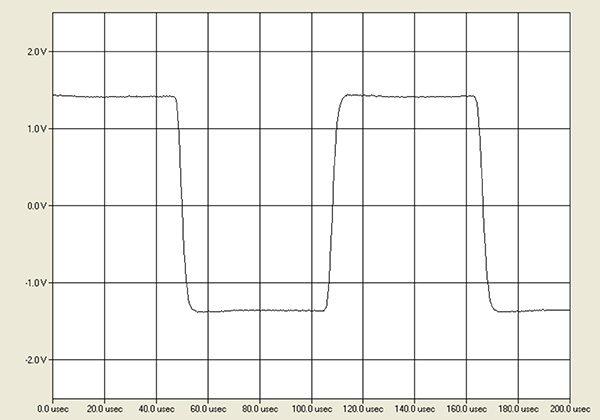
The output impedance in mono mode was 0.11 ohms at 20Hz and 1kHz, 0.18 ohms at 20kHz, all these values including the series impedance of 6' of spaced-pair cable. The stereo-mode impedances were not significantly lower, at 0.09 ohms at low and middle frequencies rising to 0.13 ohms at the top of the audioband. Even in mono mode, the variation in the small-signal frequency response with our standard simulated loudspeaker (fig.1, gray trace) was minimal. The response into 8 ohms (blue trace) and 4 ohms (magenta trace) is flat in the audioband, neither reaching –3dB until 100kHz, but the increase in output impedance at high frequencies reduces the 2 ohm bandwidth (red trace), the output at 20kHz lying at –0.5dB. The Electrocompaniet's reproduction of a 10kHz squarewave into 8 ohms (fig.2) was excellent, with very short risetimes and no overshoot or ringing.
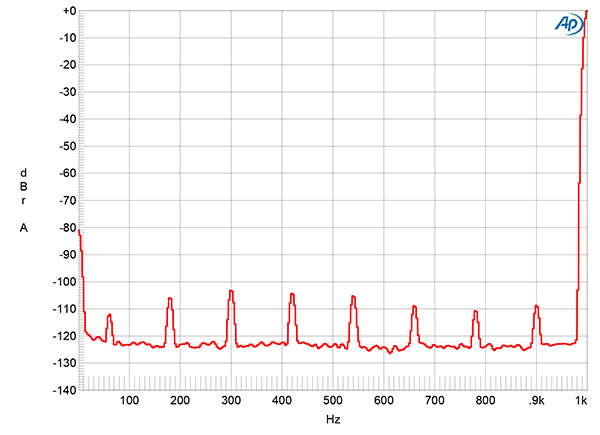
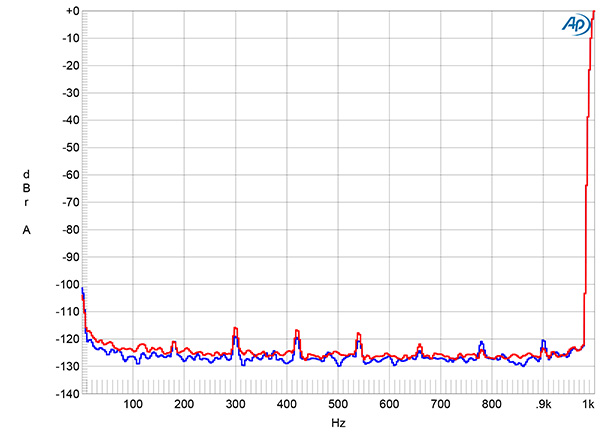
The unweighted, wideband signal/noise ratio (ref. 1W into 8 ohms), taken with the input shorted to ground, was an excellent 79dB. This ratio improved by 10dB when the measurement bandwidth was restricted to 22Hz–22kHz and by another 3dB when A-weighted. This is a quiet amplifier. Spectral analysis of the low-frequency noisefloor while the Electrocompaniet drove a 1kHz tone at 1Wpc into 8 ohms (fig.3) revealed extremely low levels of both random noise and power supply–related spuriae at 60Hz and its odd-order harmonics. The random noise and the spuriae were even lower in two-channel mode (fig.4).
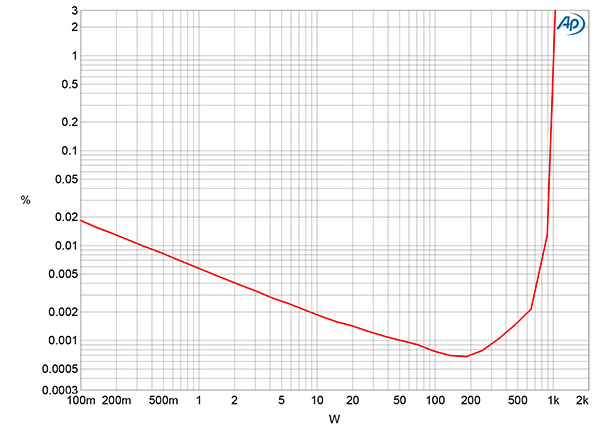
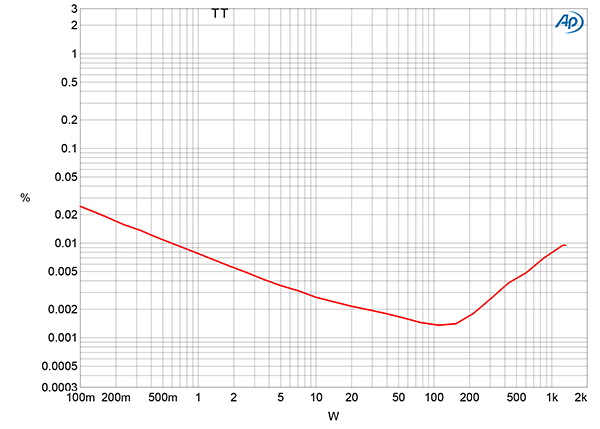

Electrocompaniet specifies the AW 800 M's maximum power in mono mode as 800W into 8 ohms (29dBW), 1500W into 4 ohms (28.75dBW), and 2200W into 2 ohms (27.4dBW). With our usual definition of clipping—when the THD+noise reaches 1%—the AW 800 M exceeded its specified maximum power, clipping at 1000W (30dBW, fig.5). However, when I repeated this test into 4 ohms, the 10A fuse on the rear panel blew at 1300W (28.2dBW), which is why the trace in fig.6 stops when the THD+N was <0.01% (footnote 2). In stereo mode with both channels driven, the AW 800 M didn't quite meet its specified power of 300Wpc into 8 ohms and 600Wpc into 4 ohms (both powers equivalent to 24.77dBW), clipping at 290Wpc into 8 ohms (24.6dBW, fig.7) and 460Wpc into 4 ohms (23.6dBW). At these high powers, the shortfall will be inconsequential.

The downward slope of the traces below 100W in figs.5 and 6 indicates that below this power, actual distortion lies below the noisefloor. I examined how the percentage of THD+N in both channels varied with frequency at 28.3V, equivalent to 100W into 8 ohms, 200W into 4 ohms, or 400W into 2 ohms (fig.8). While the distortion rose as the impedance decreased, the THD+N percentage was still very low. More importantly, it didn't rise significantly in the top audio octaves.
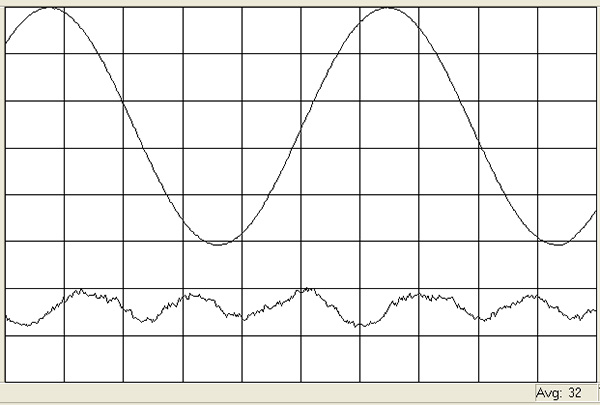



The distortion waveform in mono mode was predominantly the third harmonic (fig.9), lying close to –110dB (0.0003%) with the amplifier driving 28.3V into 8 ohms (fig.10). While the third harmonic rose to –90dB (0.003%) at the same voltage into 4 ohms (fig.11), this is still extremely low. As expected (footnote 3), the second harmonic was higher than the third with the amplifier in two-channel mode (fig.12), but both harmonics were still extremely low in level.
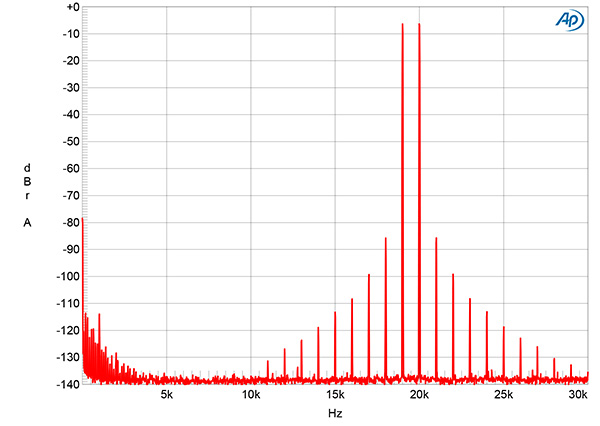
With the AW 800 M in mono mode driving an equal mix of 19 and 20kHz tones at 200W peak into 4 ohms (fig.13), the level of the 1kHz difference product was negligible, and the higher-order intermodulation products all lay below –86dB (0.004%).
With its very low levels of noise and distortion and its very high powers, the Electrocompaniet AW 800 M is a veritable paradigm of modern solid state amplifier design.—John Atkinson
Footnote 2: In his manufacturer's comment, Geir Svihus, Chief Product Developer Electrocompaniet. wrote "Regarding the blown fuse: We intentionally set the fuse ratings as low as possible to provide maximum protection against safety hazards. Dynamic output power is limited only by the output-current trip level. The AW 800 M has an output-current trip level of around 50A; the AW 800 M will happily supply output power up in excess of 1.5kW into 4 ohm and 2 ohm loads. However, prolonged operation at these levels even at output current below the trip limit, as can occur during heavy testing, may overload the main fuse. Such sustained power levels will never occur during music playback. The fuses will not blow."
Footnote 3: In mono mode the two channels' outputs are bridged, which, with perfect matching, will eliminate even-order distortion.

This is totally unrelated to audio...
I love the phrase "the world is a backdrop for my ego".
I don't know if Jason came up with this, but it's brilliant.

... a blind, level-matched protocol for their amplifier comparisons and, thus, came to the conclusion that one of the higher-end Yamaha integrated amps could provide as much amplifier performance as anyone needed. If you wanted an even higher level of construction, then there was Accuphase.

..that John Atkinson is this era's answer to Julian Hirsch. JA1 has proudly carried forward the tradition of measurement, which Hirsch pioneered in the 1960s and '70s.
Of course, I mean the comparison as a compliment to JA1 and his assiduous work over the years.
As for JVS's uninformed (the most polite way I could put it) and gratuitous slam of Hirsch, all I can say is that I am embarrassed for you. It is not even factually correct.

Mr. Hirsch reviewed everything solely based on measurements and everything sounded alike to him. Occasionally he described the build quality nicely. I'm not sure I ever read a bad review of any component he was ever assigned to evaluate. His legacy is of being a tester. His skills as a writer - especially when compared to masters of the language suchg as JVS, Herb, JA 1 and 2, Alex, "Sam T", - the less said the better.

Have you ever read a bad review here? Stereophile says they review products they like. Maybe it was the same for Mr. Hirsch?

First off, Stereophile and other magazines are not Consumer Reports. Most if not all magazines, do not give bad reviews to products/places etc. They are not news organizations doing investigative reports. This holds true for Motor Trend, Wine Spectator, Conde Nast Traveler etc. They may like some products more than others but Stereophile will probably choose to NOT review something rather than alienate an advertiser. Not sure if you know this, but print journalism is fragile business these days. PS - And I think the reviewers like some products more than others - they just say it politely - and JA 1 HAS pointed out flaws in measurements etc. He will not say this product is a piece of shit but he has said there are flaws etc. and raise an eyebrow about the engineerings etc. Mr. Hirsch on the other hand, did not go into great detail about "the sound" of equipment. He wrote about features, new technology, the size and shape and he was obsessed like the rest of the audio industry w THD as the yardstick for everything.

I would trade a little less purple prose from JVS for a scintilla of understanding of electronics.
I often wonder if JVS could tell you what Ohm's law is. He certainly can't explain Nyquist to you. He seems to think it's optional.

I don't know what Ohm's Law and I don't effing care. I know some basics. I know what certain topologies mean. I listen to music for how it makes me feel. I listen to equipment that I think sounds good. JA is the Ohm's law expert. He knows measurements and the tech. Do you think most film critics went to film school? Do all food critics have degrees from the Culinary Institute? Do automobile reviewers have degrees in mechanical engineering or automotive design? All probably not. THEY ARE. WRITERS FOR ENTERTAINMENT CONSUMER MAGAZINES. THEY WRITE. THEY DON"T WRITE WHITE PAPERS. Jeez some of you really just don't get it and are so naive and uninformed about the role of magazines.

Johnny, I always liked your guitar playing.
You claim you know basics, but if you don't know Ohm's law, you don't know basics.
How was New Orleans?

Julian Hirsch was utterly bereft of any insight or conviction. I read Stereo Review for years on the news stand (without purchasing but my first
copy) and other than specs about mainstream receivers, there was nothing of any value for prospective consumers to compare, contrast or draw conclusions from. Utterly worthless and an insult to the paper it was printed on.
Folks that crap on Stereophile for being 'marketing' for their largely positive reviews are lost in an era where truly crap components made their way at the marketplace in the 1980's. To equate Stereophile and Stereo Review as being similar should get you banned from this (and all) audio websites.
I find it catastrophically offensive that someone one would state those two magazines are similar and yet question the judgment of Johnny for knowing the difference and then claiming he doesn't know anything because he doesn't know or value Ohm's law. Heelarryous.
(Julian also 'reviewed' Ohm speakers positively and they were absolute garbage musically.)

I don't need to know anything about Ohm's Law to get the magic of Haydn string quartets or Johnny Thunder's guitar playing on Personality Crisis. I don't need to be a metallurgist to know that my All Clad frying pan outperforms the $10 one I bought as a college student either. Many of you equate science and engineering knowledge with musical performance and enjoyment. It's a little art, science and magic and you can't quantify it. That piece of equipment that doesn't measure well and costs a lot can't possibly be better than the one that costs less and measures "perfectly." Ha.

I would party with you any time.. even if it meant crossdressing to New York Dolls and destroying archaic thought!
You fucking RULE Johnny.

I'm glad you gentlemen have a publication that caters to your audiophile heuristic -- if it's extremely expensive and measures poorly, it must be the best.
This is what keeps our beloved Stereophile (as well as the far less interesting TAS) in business.

Clearly you are insincere.
And no, drawing asinine conclusions is not art nor science. You would actually need to listen to equipment over time to determine its greatness. Listening critically is the key and takes time and experience- And occasionally going to audio shows to compare and contrast with one's own biases and past experiences
What you are essentially saying is you just like trolling this magazine's website to convince subscribers that this magazine isn't worth our time. And the measurements and their limited scope is somehow tantamount to all else.
That is the definition of stupid.

I am absolutely not being insincere.
Stereophile, though no longer in its salad days, is still the most important publication in the audiophile ecosystem. Even with the emergence of sites like ASR.
And without people like you and the late Mr. Thunders, who sincerely believe the ascientific cant you spout reflexively like a mantra each time a trained engineer comes atcha, Stereophile would disappear.
That said, two things can be true at the same time. A) I believe Stereophile is important and B) I also think, well, you know what I think of JVS and his ilk as well as your nonsense.
I would hope that we all kinda grok that when all of us older guys exit the soundstage, the kind of robust, cranky debating and infighting with which many have been consumed for lo these many years will be no more.
P.S. As far as "the definition of stupid," you appear to be more familiar with that than I.

Appear? You couldn't discern bullshit from truth, engineering or subjective listening. You project a ton in trying to foist your own value here. Keep hiding behind whatever supposed superior knowledge you have.
You have none with statements like "expensive and measures poorly.. must be good." What are you bringing forward with statement like that? Zero substance, just the same trite accusations ad nauseum.
I do not need any of your 'observations'. You're a troll, pure and simple, with zero value to audiophiles.

What primordial semi-scientific ooze are they emerging from? It's a bunch of people like you - bitter know-it-alls, relentlessly negative troll types that have to be the audio Taliban and stand up for the audio consumer and protect us from expensive equipment that measures poorly (that reminds me, where is Ortofan and why hasn't he recommended a Parasound or Marantz amp to compare w the amp JVS wrote about)? You both know better than me - me the one w the 4K tube amp that has loads of lovely 2nd harmonic distortion (by the way, there are many many revered audio engineers that designed amps w a shit ton of euphonic warmth as a foundational part of the circuit and sorry if you don't like it. Mr G said it best - why do you read Stereophile then ? To chuckle at all the suckers ?
Do you make fun of people that read Architectural Digest but live in a modest condo ? Magazine content like Stereophile is aspirational. People do not want to read magazines with average shit photographed and written about.

I think those (including myself) who place importance in measurements are aiming for "high-fidelity", not "euphonia".
Whether the album sounds good or not is a reflection of the quality of the musician and recording itself... The job of the hardware is just to get out of the way, a characteristic we can measure based on engineering principles, the goal is not inherently to "sound good" which is a subjective judgment that we're all free to hold (2nd harmonics can certainly be pleasant for some).
Audiophiles from both schools of thought can enjoy music.
I think those who are aiming for objectively high-fidelity reproduction also tend to be more sensitive to the price as a reflection of value using the objective measuring stick of low-distortion-low-noise/$100 or something like that. That's not an unfair measuring stick if that's what we want, and consistent with the overall philosophy. As a mature technology, many high-fidelity devices don't have to cost a lot of money for good engineering. For example, excellent DACs can be had for a few hundred bucks so when a $10,000 DAC comes along, it makes sense for "us" to make some comparisons and judge whether things like noise floor and distortion levels are commensurate with the price.
I don't think many objective-leaning audiophiles are jealous of the luxury priced products. It's just that much of what is being sold simply isn't "aspirational" within this view of the hi-fi hobby if the objective results don't reasonably correlate with the price structure.
Yes, perhaps Stereophile and the subjective reviews are not suited for this form of audiophile. Maybe the "high end" with its values and heroes isn't something certain audiophiles will appreciate. Although it's still nice to see the measurements and appreciate (or not) the current newest products. Plus it's nice to read about music recommendations.

the trolling types aren't. Their specific intent is to sh-t on anything else and to be negative contrarians. The audio Taliban again. I don't troll a good review of a lower priced well reviewed component and make fun of it and then respond here and say "but for $5k MORE you can get this AVM amp." or god forbid suggest an amp made in Asia (except for the amps that THEY endorse.). I shouldn't let it get to me but I'm not alone in the dread of reading the comments of these negative noodnicks with low budgets but big egos and opinions. I'm also not advocating that a good system has to cost 6 figures either. My system is quite modest with no component costing over 5k.

I think those (including myself) who place importance in measurements are aiming for "high-fidelity", not "euphonia".
High fidelity is not actually well-connected with a few measurements. That's an assumption. And euphonia is a negative projection against the listeners who obviously hear beyond them.
Whether the album sounds good or not is a reflection of the quality of the musician and recording itself...
Incorrect. Great audio identifies itself by how it recaptures everything, warts and all. Once you hear it you get it.
The job of the hardware is just to get out of the way, a characteristic we can measure based on engineering principles
Also incorrect because again there are no measurements for that sound. 'Getting out of the way' is an empty ideal when there's no way to establish it. Especially when it's assumed to be the product of measurements.
...the goal is not inherently to "sound good" which is a subjective judgment that we're all free to hold (2nd harmonics can certainly be pleasant for some).
That's just phoning in your projection, and the 'subjective' part is a tell for your bias. Look what comes next.
I think those who are aiming for objectively high-fidelity reproduction
There it is. The 'objectively' better sound is assumed to exist while the subjective sound is projected to be inferior, all based on assumptions about measurements.
Yes, perhaps Stereophile and the subjective reviews are not suited for this form of audiophile.
That's probably true, just not the objective part. Too many unfounded assumptions.

... best-selling brands of power amplifiers at the major on-line dealers?
One of them is not Electrocompaniet. Rather, it's brands such as Parasound, Marantz, NAD and Rotel.
Perhaps "people" do not want to read magazines with average products photographed and written about, but those average products are what they are buying.

Britney Spears sold more records than Leonard Bernstein but that doesn't mean the NY TIMES is going to write about her. Crosley sells more turntables than Linn. Should we write about them ? This is not an argument about quantity and what sells the best. It's not even an argument about quality because there is absolutely nothing to disparage about Parasound or Marantz. But that doesn't mean it is sexy to write about or in magazine parlance - a story worth writing about. All you are proving is that amps in the $500-$2500 range sell more than pricier models. Duh. Motor Trend writes about the Ford 150 (the same way that Stereophile reviews lots of Parasound) but they also write about the latest Porsche and Mercedes and Lambo...So go publish your own magazine where they only review stuff that sells well to the masses. See how it does. See how long it lasts. See how little advertising you get. See how f-ing boring it is to read about. If your point is to advocate how good a value Parasound is, just say it without pointing out that to spend more for something else is misguided. I could have purchased the Parasound JC3+ phono stage - there were aspects of that stage that really appealed to me but it simply doesn't fit in the space I have and there I own a small UK stage like an EAR 834p. People need choices for their personal preferences that go beyond simply god damn measurements.

Whatever the designer has decided for euphonic or accurate is that designers conscious decision, not a failing of accuracy-minded value parameters.

"if it's extremely expensive and measures poorly, it must be the best."
Is that really what you meant to write?
"This is what keeps our beloved Stereophile (as well as the far less interesting TAS) in business."
Because it's a conspiracy too?

Despite his endless misspelling of Cynic, I enjoyed Aczel. Once he discovered the market for obstreperous people who couldn't appreciate the music made by what they could not afford, he formed something of a balance. At least in his mind. And unlike today's version of the same journalistic affectation, he could write.
I can't think of a illustrative corollary but then I haven't spent a lot of time on it either.

... if an amplifier has flat frequency response, vanishingly small static and dynamic linearity errors, high enough input impedance and low enough output impedance, noise level below audibility, and high enough channel separation, then it will not have a detectable sound quality. This assertion, they claimed, was confirmed by their ABX listening tests.
If one needed more power (100W @ 8 ohms/200W @ 4 ohms) than the Yamaha integrated amp could supply, then they recommended power amps from Boulder, Bryston or Rotel.
Their impression was that the Boulder was overbuilt (and priced accordingly), while the (non-Michi) Rotel was quite acceptable, and the Bryston was worth the added cost (over the Rotel) given its 20-year warranty.
Their technical editor was a degreed EE with a Ph.D., who provided an analysis of the circuit design for the amplifiers under review.

...vanishingly small NON-linearities, not vanishingly small linearities.

... either non-linearities or linearity errors.

Seems they made a categorical statement that would speak for all listeners. Did they speak for all samples and phenomena too?

And this too can be measured.
http://archimago.blogspot.com/2021/08/summer-musings-no-not-all-amplifiers.html
The question is how different the amps are from each other and whether the speaker match results in audible changes like frequency response.
But yeah. Within reasonable technical parameters, most good quality amps I think will sound very similar if we were to A/B compare; more so than some might want to admit especially with huge price differences! ;-)

The effort that goes into measurement crystal ball gazing while denying expert reports of what it actually sounds like must be exhausting.

Technical knowledge? Listening experience? Have they passed some test and received a certificate? Have they even had their hearing checked? Do they bother to account for the inevitable unconscious biases that can affect listening perceptions?
Let me rephrase it thusly: Which would better inform me what a product sounds like? A suite of measurements, or the musings of an "expert" listener who listens to a piece of gear in a different room than mine, with a different set of ears than mine, with a different brain than mine, with different connecting gear than mine, and with different music preferences than mine?

You roll up on the fine downtown restaurant and bellow at the chef, demanding that he's a commercial fraud but he also has to hand you a chemical analysis of a dish you can't afford to order and will never appreciate. You're probably tons of fun around anybody who enjoys normal human experiences. Sommeliers must love you. Enthusiasts of all kinds adore you.
You just actually projected that better sound is on tap for people who can interpret it from tables and images but can't hear it in person.
And that hearing test part is just delicious, because nobody can appreciate the sound of music without perfect ears. Beethoven composed nothing but noise.
I don't think you're here for either sound or music. It's more obvious than that. You audio wedding crashers are widely know. JohnnyThunder already said it
What primordial semi-scientific ooze are they emerging from? It's a bunch of people like you - bitter know-it-alls, relentlessly negative troll types that have to be the audio Taliban and stand up for the audio consumer and protect us from expensive equipment that measures poorly
the trolling types aren't logical. Their specific intent is to sh-t on anything else and to be negative contrarians. The audio Taliban again.
I shouldn't let it get to me but I'm not alone in the dread of reading the comments of these negative noodnicks with low budgets but big egos and opinions.
Mr G said it best - why do you read Stereophile then ? To chuckle at all the suckers ?
Do you make fun of people that read Architectural Digest but live in a modest condo ?
So why are you here? We know you can't identify what you admit you can't hear. So you are here instead to elevate yourself by being obnoxious. Pointless and wrong came along for the free ride.

... be amazed by this quote from one of his reviews of a particular power amplifier:
"Its listening quality is superb, and not easily described in terms of laboratory measurements. Listening is the ultimate test and a required one for full appreciation of the [amplifier]."

With this word Victor "unique", are you saying it's "colored", or do you think it's more "real" than say all the Class-D's you've been listen to? (forget about tubes they're all colored in some way)
Second thing JA about these "bridged" (stereo) monoblocks amps coming from "big BJT solid state" background where are the transformers?? the only place could be in the very shallow gap under the power supply caps, and that doesn't seem enough room for 2 x decent sized toroidal trannies + electrostatic shielding?.
BTW love the unmolested (with any filtering) near perfect 10khz square wave!
I would have loved to see the 2ohm wattage "bridged", probably wouldn't even get to the 8ohm wattage figure, unstable/blow/fuse.
Cheers George

... between the front panel and the banks of filter capacitors.
https://electrocompaniet.com/cdn/shop/files/electrocompaniet-AW800M-monoblock_poweramplifier_above.jpg
While Hi-Fi News did not perform continuous power tests below 4 ohms, according to their dynamic/peak output tests at 2/1 ohm loads in stereo mode the AW800M was capable of 1352W/1854W.
https://cdn.shopify.com/s/files/1/0004/3352/0692/files/Electrocompaniet_EC4.8MKII_AW800M_Outstanding-award.pdf

Have you heard them recently? I mean, you haven't and "The world is just a backdrop for your ego.. " Just kidding, George.

Ooooops! correct, I was looking at this, thinking just the front panel was missing. DUH!!! Thanks for that.
https://ibb.co/dLrqnC6
Cheers George

Although eloquently written this review is very difficult to fathom. Am I supposed to understand - behind the lyrical descriptions of miso soup - that this amplifier has terrific bass but embodies the music in a veil thus obstructing transparency?

"lyrical descriptions"
Gotta read between the lines there Mikee
Well the Miso has seaweed, so it's gunna sound/smell a "bit fishy"?
Cheers George

Basically, it’s two incomplete parts of the hobby thinking they each have it all figured out.
Tribal cults at either extremes.


Could anything be less important than the audiophile concerns being discussed on these pages? The sound quality of home audio amplifiers?
Really? Is no one here watching the news?
The above was an admittedly dumb post on my part. When I made it I had just finished watching a documentary about the war in Israel.

Decades ago I read the testimony of one German woman—someone who was anything but a Nazi sympathizer—who said that during the darkest hours of WWII, she kept her hope alive by listening to a specific Beethoven string quartet over and over. Music plays a vital part in our mental and spiritual health; it helps connect us with something far greater than ourselves.
Admittedly, one does not need a $50,000 set of monoblocks to feel the power of music. But for those of us who find affirmation and support in music, and to whom nuance and fine differences matter, sound quality is an important consideration. When a given piece of equipment brings me closer to the source of creation, I value it highly. In this respect, for many people other than myself, audiophile pursuits are more than a "hobby;' they are about connecting us with something far greater than ourselves.

I agree with Mr. Serinus completely!